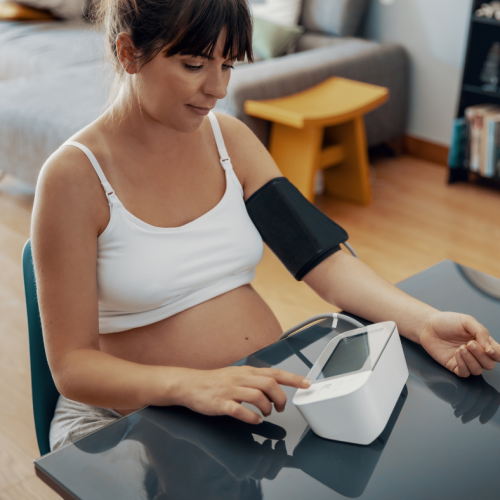Preeclampsia
Preeclampsia is a complication of pregnancy. With preeclampsia, you may have high blood pressure, high protein levels in your urine indicating kidney damage (proteinuria), or other signs of organ damage. Preeclampsia usually begins after the 20th week of pregnancy in women whose blood pressure was previously in the normal range.
Can preeclampsia be dangerous?
If preeclampsia is left untreated, it can lead to serious – even fatal – complications for both the mother and the baby. Early delivery of the baby is often recommended. The timing of delivery depends on how severe the preeclampsia is and how many weeks pregnant you are.

Before delivery, treatment for preeclampsia includes careful monitoring and taking medicines to lower blood pressure and manage complications. Preeclampsia can develop after a baby is born, a condition called postpartum preeclampsia.
Symptoms of preeclampsia
The main feature of preeclampsia is high blood pressure, proteinuria, or other signs of damage to the kidneys or other organs. You may not have any noticeable symptoms. The first signs of preeclampsia are often detected during routine prenatal exams by a doctor.
Along with high blood pressure, preeclampsia signs and symptoms may include:
- Excess protein in urine (proteinuria) or other signs of kidney problems
- Decreased levels of platelets in blood (thrombocytopenia)
- Increased liver enzymes that indicate liver problems
- Severe headaches
- Changes in vision, including temporary loss of vision, blurred vision or light sensitivity
- Shortness of breath, caused by fluid in the lungs
- Pain in the upper belly, usually under the ribs on the right side
- Nausea or vomiting
- Sudden and excesses weight gain or swelling (edema), particularly in your face and hands
Cause of preeclampsia
The exact cause of preeclampsia likely involves several factors. Experts believe it begins in the placenta – the organ that nourishes the fetus throughout pregnancy. Early in pregnancy, new blood vessels develop to supply oxygen and nutrients to the placenta.
In women with preeclampsia, these blood vessels do not appear to develop or function properly. Problems with blood circulation in the placenta can lead to irregular regulation of blood pressure in the mother.
Types of high blood pressure disorders during pregnancy
Preeclampsia is one high blood pressure (hypertension) disorder that can occur during pregnancy. Others include:
- Gestational hypertension– is high blood pressure that begins after the 20th week of pregnancy without problems in the kidneys or other organs. Some women with gestational hypertension may develop preeclampsia.
- Chronic hypertension– is high blood pressure that was present before pregnancy or that occurs before 20 weeks of pregnancy. High blood pressure that continues more than three months after a pregnancy also is called chronic hypertension.
- Chronic hypertension with superimposed preeclampsia – occurs in women diagnosed with chronic high blood pressure before pregnancy, who then develop worsening high blood pressure and protein in the urine or other health complications during pregnancy.
Treatment and prevention of preeclampsia
Medication
The best clinical evidence for prevention of preeclampsia is the use of low-dose aspirin. Your doctor may recommend taking an 81-milligram aspirin tablet daily after 12 weeks of pregnancy if you have one high-risk factor for preeclampsia or more than one moderate-risk factor.
It’s important that you talk with your doctor before taking any medications, vitamins or supplements to make sure it is safe for you.
Lifestyle and healthy choices
Before you become pregnant, especially if you have had preeclampsia before, it is a good idea to be as healthy as you can be. Talk to your doctor about managing any conditions that increase the risk of preeclampsia.
Treatment at A7 Health to start Exercising after Pregnancy:
Get Physiotherapy – Book an appointment with a Physiotherapist at A7 Health who will assess you in a 45 minute consultation and provide you with treatment alongside a treatment plan to manage your pain. Some of the treatments include:
- Lower back mobility exercises.
- Massage.
- Mobilisations on any stiff joints such as your hips, lumbar spine joints or the sacroiliac joint (SIJ).
- Pelvic floor strengthening exercises.
- Strengthening exercises for your abdominal muscles.
- Practice relaxation techniques.
- Prevent or treat urinary incontinence.
- Relieve back pain.
- Relieve pain during sexual intercourse.
Join an exercise class (with a Biokineticist) – Moderate exercise, such as walking, has been shown to help relieve back and pelvic pain during pregnancy. Stretching can help relieve sore muscles. Join an exercise class led by an A7 Health Biokineticist who will teach you exercises that will strengthen and relax muscles and help you to reduce the likelihood of pain after pregnancy. These exercises will also help you with recovery after you give birth.
